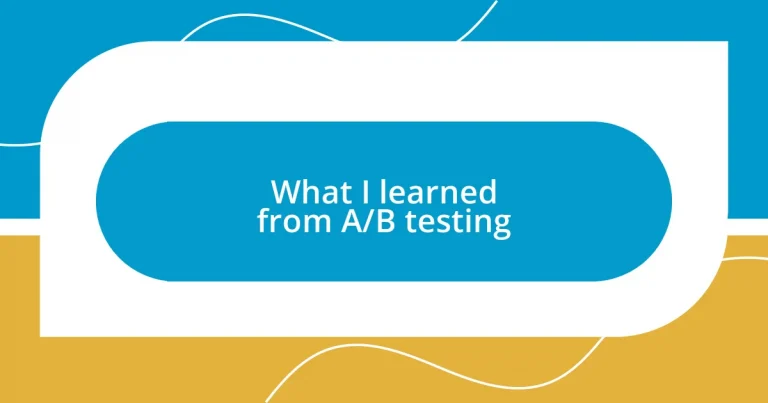Key takeaways:
- Define clear objectives and ensure an adequate sample size to gain reliable insights from A/B testing.
- Design impactful test variations by focusing on one element at a time and gathering user feedback for improvements.
- Continuously optimize by engaging with your audience and iterating based on long-term performance, rather than relying on one-time results.
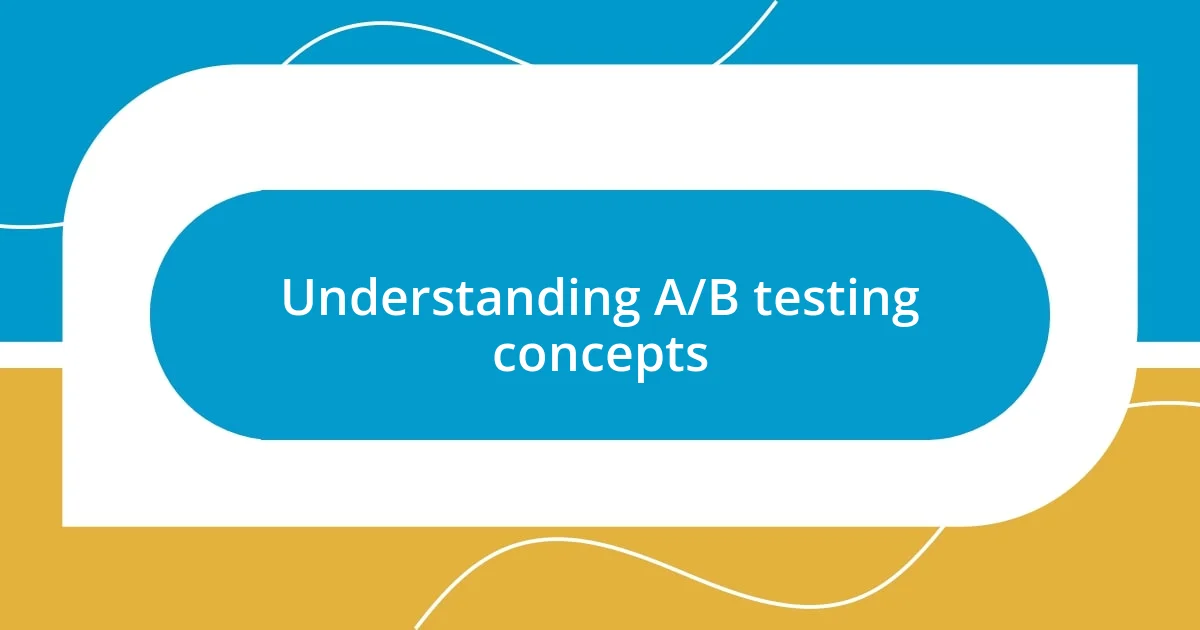
Understanding A/B testing concepts
A/B testing is essentially a way to compare two versions of something to find out which one performs better. I remember the first time I conducted an A/B test on an email campaign, I felt a mix of excitement and anxiety. Would the changes I made resonate with my audience, or would I completely miss the mark?
One of the key concepts I learned is the importance of defining clear goals before you start the test. It’s easy to get caught up in the numbers, but having a clear objective, like improving click-through rates, helps keep the focus on what really matters. Have you ever set out to test something without a clear endpoint? I have, and it often leads to confusion and frustration.
Another crucial aspect is the idea of sample size. Early on, I made the mistake of running tests with too few visitors, which skewed the results. It felt disheartening to watch data fluctuate without any real significance. Knowing that a larger sample provides better insights really changed my approach to designing tests; now I wouldn’t dream of skimping on this essential part of the process.
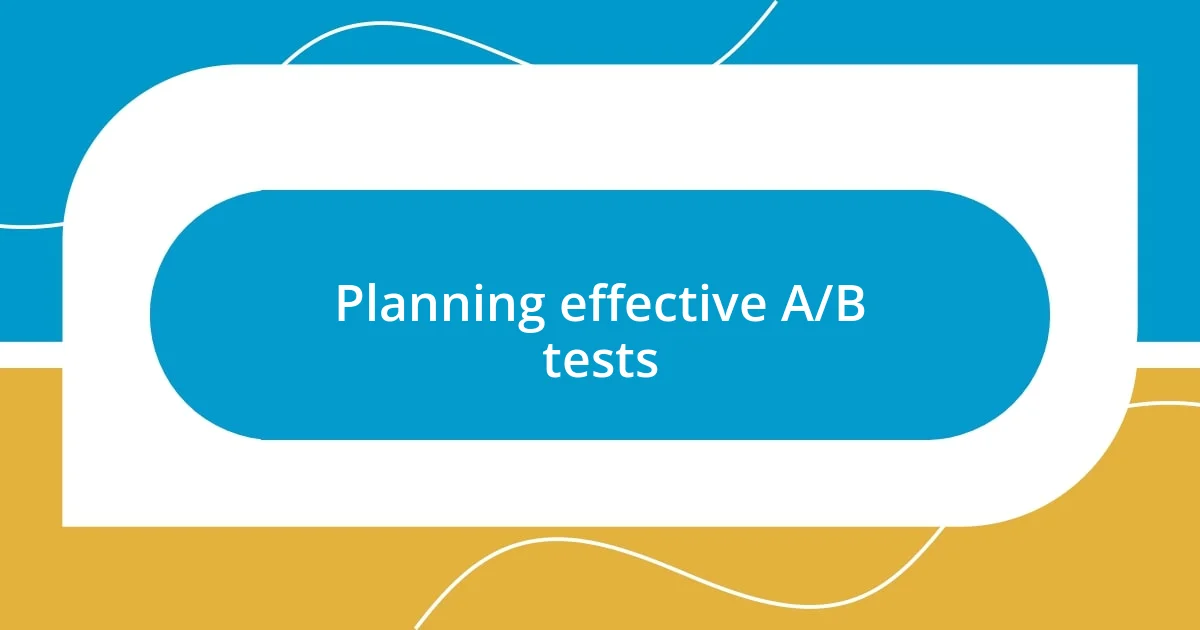
Planning effective A/B tests
Planning effective A/B tests requires thoughtful consideration and a structured approach. I vividly remember one of my early attempts, where I hastily decided on a few changes based purely on gut feeling. The results were puzzling, almost disappointing, because I hadn’t truly understood what I was hoping to learn. When I shifted my focus to a strategic plan, I found that aligning changes with specific, predetermined goals made all the difference.
Here are some critical elements to incorporate into your planning phase:
- Define Your Goals: Be specific about what you want to measure, whether it’s conversion rates, engagement levels, or something else entirely.
- Select Your Variables: Choose one or two elements to test at a time; changing multiple components can lead to ambiguity in your results.
- Determine Sample Size: Ensure your test reaches enough users to attain statistically significant results, helping you draw more reliable conclusions.
- Establish a Timeline: Decide how long the test will run. Too short can lead to inconclusive results, while too long might waste valuable time.
- Analyze and Adjust: Plan for how you’ll analyze results and what follow-up actions you might take based on the findings.
With these foundational steps, you’ll find that planning your A/B test can be not only organized but also exciting—a fascinating journey into understanding your audience better!
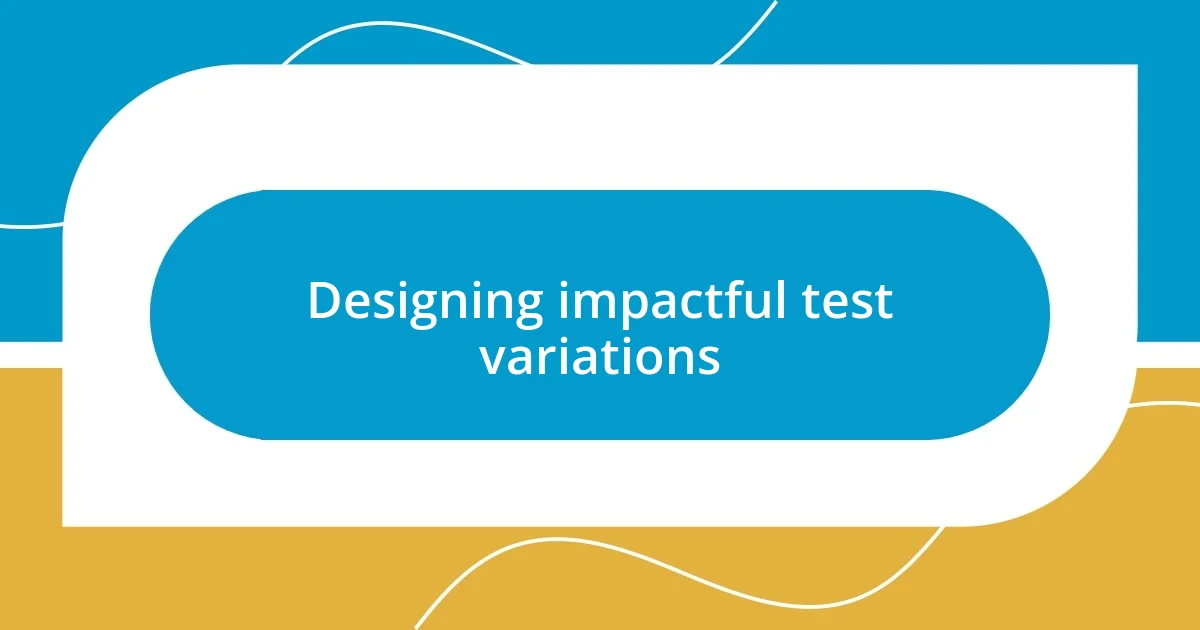
Designing impactful test variations
Designing impactful test variations is one of the most exciting aspects of A/B testing. I recall a particular project where I tested two distinct layouts for a landing page. Selecting contrasting colors and different call-to-action buttons helped me understand the visual impact on user behavior. It was remarkable to see how small differences could lead to significant variations in user engagement.
When creating variations, I learned that it’s crucial to focus on one element at a time. In one instance, I decided to test a new headline while keeping the same imagery. This clarity allowed me to pinpoint the variation’s effect more precisely. The outcome was genuinely enlightening, showing me how much a compelling headline can influence click-through rates.
To maximize your test variations, keep in mind that user feedback can be gold. I once let a small segment of my audience preview a variation before fully launching it. Their insights on the design tweaks I contemplated were invaluable. It reinforced my belief that user input, combined with data-driven decisions, leads to successful testing.
| Element | Description |
|---|---|
| Visual Design | Utilize contrasting colors and layouts to see which resonates more with users. |
| Text Variations | Test one aspect at a time, like headlines, to measure its direct impact. |
| User Feedback | Engage a small audience for insights before broader implementation. |
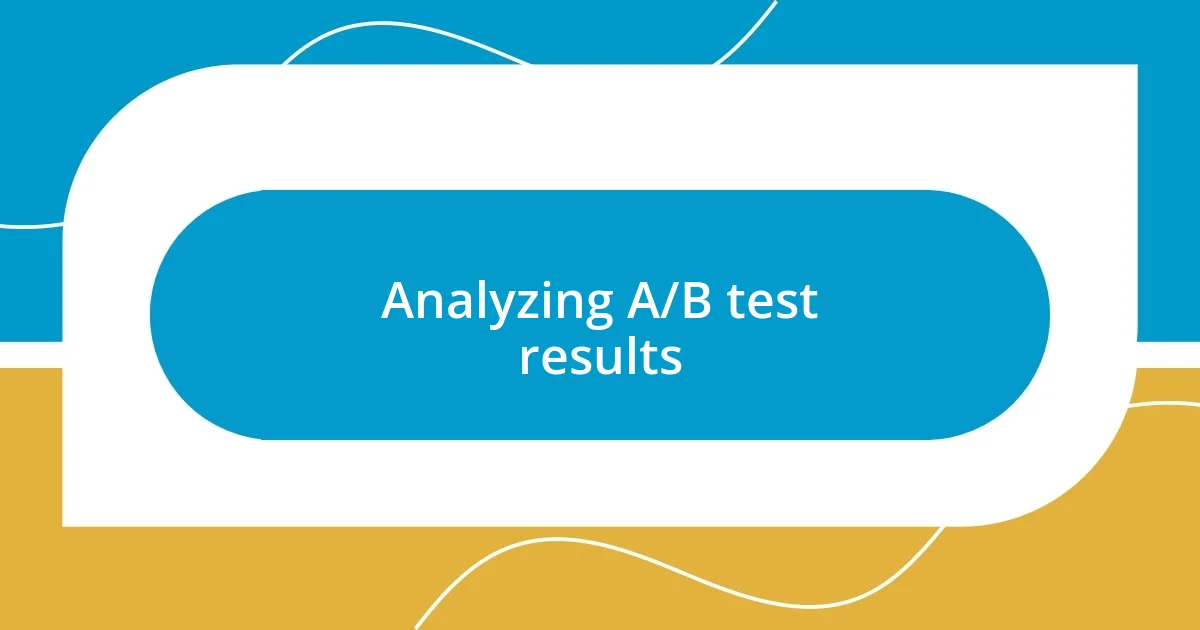
Analyzing A/B test results
Analyzing A/B test results goes beyond simply comparing numbers; it’s about understanding the story behind them. I recall a time when I was thrilled to see a surge in conversion rates after a recent test, only to dig deeper and discover that the increase was primarily from a specific demographic. It made me realize how crucial it is to segment your data. Have you ever found results that looked promising at first glance but told a different story once dissected? That’s the kind of insight that can drastically shape your marketing strategy.
One powerful approach I’ve implemented is looking closely at user behavior metrics. For instance, during one test, I noticed users who clicked on a particular button weren’t converting as expected. After checking the session recordings, I discovered they were getting distracted by other elements on the page. It was eye-opening! By understanding the user’s journey rather than focusing solely on the final conversion, I was able to identify friction points and make necessary adjustments.
Don’t overlook the importance of statistical significance when analyzing results. I once declared a winner based on a slight edge in performance, only to realize that my sample size was too small to draw any meaningful conclusions. It taught me a vital lesson: a small difference isn’t enough to validate a change. This experience reinforced the need to ensure my tests had robust sample sizes, which ultimately leads to more reliable insights and more informed decisions.
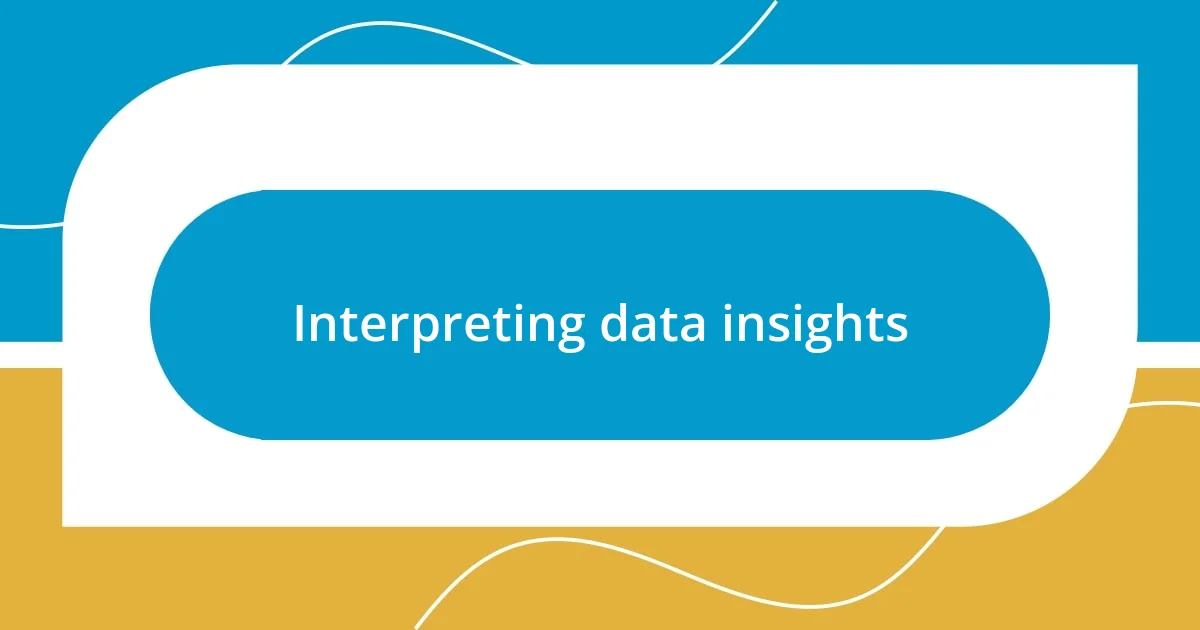
Interpreting data insights
Interpreting data insights feels like piecing together a puzzle. One time, after running an A/B test for a newsletter sign-up form, I was excited to see the preliminary results. Initially, the numbers suggested a clear winner, but as I analyzed them further, I realized that the spike in sign-ups came from a newer audience segment. It drove home the importance of understanding who your data is coming from, not just the numbers themselves.
While analyzing the results, I’ve learned to trust my instincts and ask deeper questions. In another test, I noticed that even though one variant had a higher click-through rate, the user engagement afterwards was significantly lower. Why were they clicking but not staying? This reflection led me to realize the importance of a cohesive user journey instead of merely focusing on the click itself. It felt like a mini-revelation that transformed my approach to user engagement.
I also can’t stress enough the significance of tracking changes over time. After implementing a change based on an A/B test, I made it a habit to revisit the metrics weeks later to see if the initial results were sustainable. Once, I got overly enthusiastic about a 30% drop in bounce rates, but a few weeks later, the numbers bounced back to normal. It was frustrating, but it taught me that trends take time to stabilize and that patience and continuous observation can yield the richest insights. Have you ever experienced the thrill of an insight that faded as fast as it arrived? That’s the fine line we walk in data interpretation.
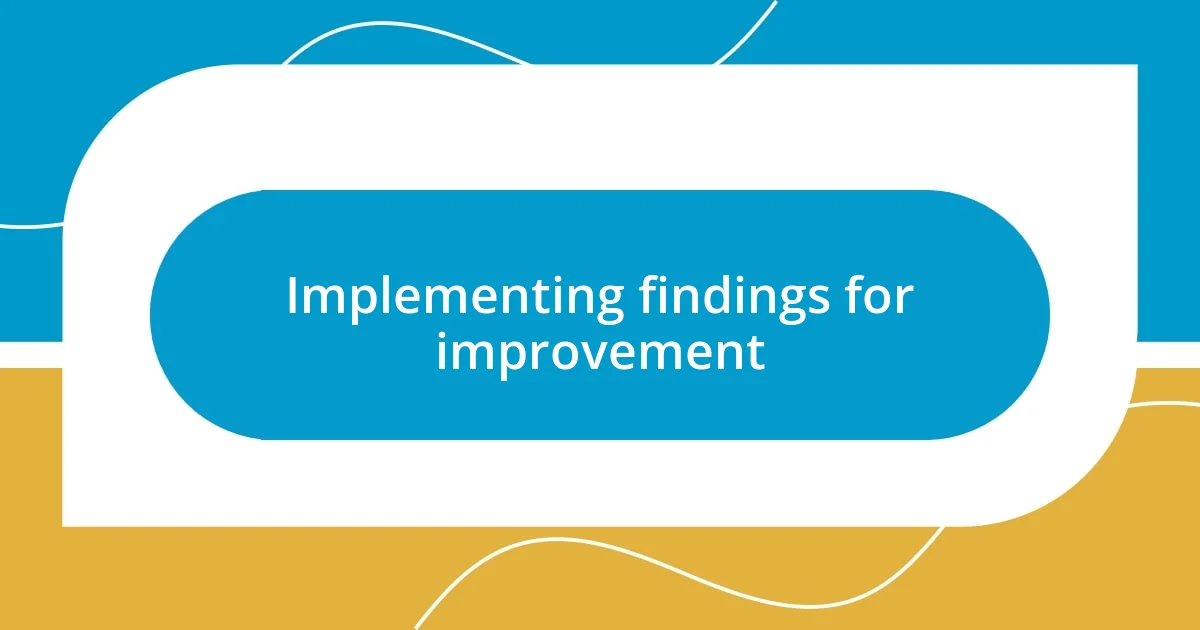
Implementing findings for improvement
Once I integrated findings from an A/B test into my website’s layout, I experienced a wave of anticipation. I had changed a primary call-to-action button based on user feedback, and like a film premiere, I couldn’t wait to see the audience’s reaction. The first few days felt electric, but it was during the second week that I noticed a drop in engagement. This moment reminded me just how critical it is to monitor not just the immediate outcomes but longer-term patterns. Have you ever felt that initial high, only to be brought back to reality as the dust settled?
In one instance, after realizing a particular color choice for a button led to increased clicks but lower conversions, I felt an unmistakable frustration. It was like hitting a home run only to have the ball caught at the wall. Analyzing why users weren’t taking the next step taught me the importance of aligning aesthetic decisions with the user’s intent. I learned that sometimes change isn’t just about what looks good; it needs to resonate with what users actually want to do. When have you faced a similar situation where aesthetics and functionality seemed at odds?
Implementing changes requires a spirit of experimentation, something I embraced wholeheartedly after one memorable test. I revamped the email subject lines based on what resonated most with my audience. The results were striking, and I felt a swell of pride seeing the open rates climb. Yet, I learned that not every success needs a radical overhaul; sometimes, minor tweaks can lead to significant improvements. This realization left me wondering—what little adjustments might you be overlooking that could make a big difference?
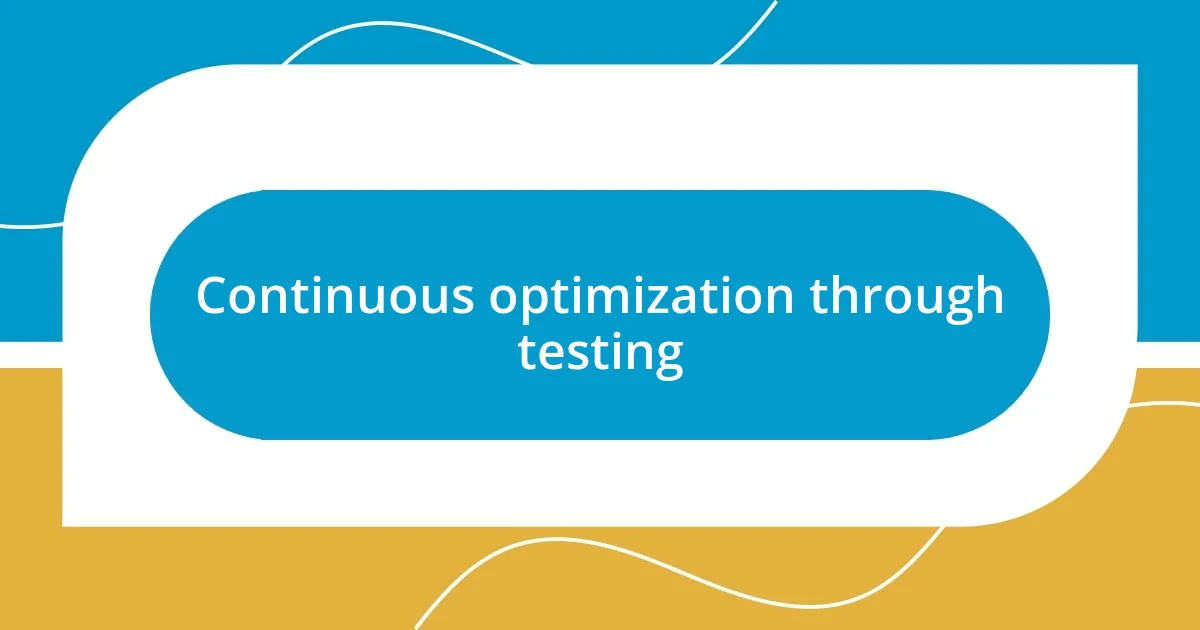
Continuous optimization through testing
Continuous optimization is a journey rather than a destination. After running a series of A/B tests on different landing pages, I discovered that regular feedback loops kept the momentum going. There was a time when I assumed a single test could define success, but I quickly learned that it’s the ongoing cycle of testing and adapting that truly drives growth. Have you ever realized that a one-time win can easily become outdated? I certainly have.
One memorable experience involved a small tweak to the phrasing of my headlines. I experimented with various versions, and while one performed well initially, its effectiveness dwindled over time. It was a wake-up call for me—success isn’t just about finding what works; it’s about consistently asking, “What’s next?” This shift in my perspective has made continuous testing feel less like a chore and more like an exciting adventure. Isn’t it liberating to think of optimization as an evolving story?
Moreover, I’ve noticed that engaging with the audience is vital for ongoing testing success. During one phase, I sought direct input from users through surveys, and the insights they provided were invaluable. With their feedback in mind, I embarked on another round of testing that yielded surprising results. It reminded me that including the audience in this process not only fosters community but often sparks new ideas I didn’t consider. Has your audience ever inspired you in ways you didn’t expect? I know mine has, and it always makes the process feel more rewarding.












